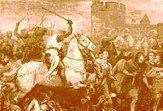I have just finished reading the War of Art:Break Through the Blocks and Win Your Inner Creative Battles by Steven Pressfield.
Steven's main contention is that writer's block or any of its artistic equivalents comes from being too close to the art until one seizes up from fear and suffers a paralysis that stops the artist from ever beginning, or else being unable to stick to the task to completion. And then he dies.....
The way to beat it is to sit down and ignore all the reasons and excuses the ego gives us not to start, no matter how valid. Once started, have a schedule to stick to that should only be broken by either World War 3 or an immediate family crisis.
If you were born to write a symphony, you must fulfill your destiny and write it or else your life has been meaningless.
His other contention is a hack writes for a market, a true artist or poet in contrast is a conduit through whom the Muses transfer into physical reality from the collective unconscious.
Much of the writing on Bob Dylan's "John Wesley Harding" album in particular stands out to me as channeled through him and not of him.
Beethoven's best work also seems to have come from the angels. The Ode to Joy from his Ninth Symphony is supremely triumphant and is one of the most loved, recognised, recorded and utilised pieces of music in Western musical history.
The true artist would pursue his creation if he was never published or never had his record released and died unheard and unrecognised. Vincent Van Gogh apparently only ever managed to sell a single painting.
All The Believers
Almost twenty five years ago, I wrote the following song:I always felt that the song was channeled 'through' me rather than coming 'from' me. It was non-typical of what I was writing at the time, and while I understood the blatant message of the song, I wasn't aware of the possible story in the song until the last year or two.
The story being that 700 years ago there was a non-violent
(amazing!) sect of Christians in the Languedoc region in France who were relentlessly pursued and tortured and killed to virtual extinction by the established ruling Christians.
At the time of writing I certainly wasn't aware of the Cathar story.
Maybe I was selected by the Muse to write this for someone who one day might find it and read it and find it vital in helping pursue an important part of his or her life's work!

They hung all the believers
They hung all the believers
Ten feet, Ten feet high
They hung all the believers,
But the believers would not die
And the truth's still walking
Yes, the truth's still walking
Just like a, Just like a man
To kill the truth you've got to see it,
But only a believer can
They burned the believers
they burned the believers
They burned their, Burned their homes
But that didn't kill the truth,
'Cos truth can stand up on its own

They cut their hearts out
They cut their hearts out
They wrung their, wrung their minds
They sought the truth to bend it,
They couldn't find it, they were blind
They hung all the believers
They hung all the believers
Ten feet, Ten feet high
They hung all the believers,
But the believers would not die



